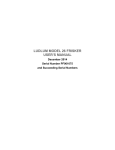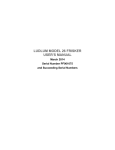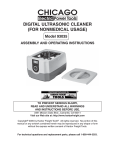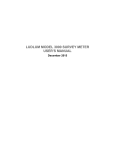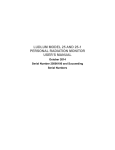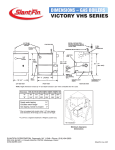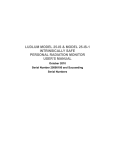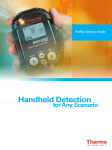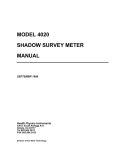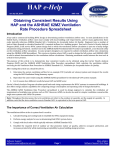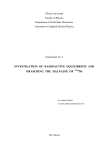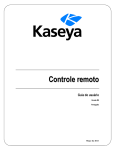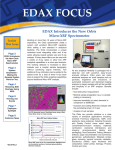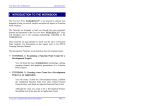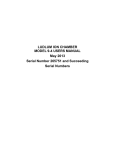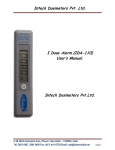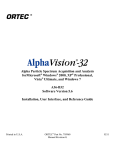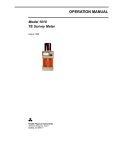Download ludlum model 26-1 frisker user`s manual
Transcript
LUDLUM MODEL 26-1 FRISKER USER’S MANUAL December 2014 Serial Number PF002366 and Succeeding Serial Numbers LUDLUM MODEL 26-1 FRISKER USER’S MANUAL December 2014 Serial Number PF002366 and Succeeding Serial Numbers Model 26-1 Frisker User’s Manual Table of Contents Introduction 1 Getting Started 2 Unpacking and Repacking 2-1 Battery Installation 2-2 Instrument Operational Test 2-3 Detector Failure Diagnostic 2-5 Detector Over Range 2-5 Instrument Use and Controls 2-6 RATE Mode Operation 2-7 MAX Mode Operation 2-8 COUNT Mode Operation 2-9 Specifications 3 Gamma Energy Compensation 4 Setup mode 5 Setup Overview 5-1 Default Setup Values 5-2 Entering Setup Mode 5-3 Setup Mode Operation 5-4 Safety Considerations 6 Environmental Conditions for Normal Use 6-1 Warning Markings and Symbols 6-1 Cleaning and Maintenance Precautions 6-2 Revision History 7 Recycling 8 Maintenance and Spare Parts 9 Model 26-1 Frisker User’s Manual Maintenance 9-1 Spare Parts 9-1 Model 26-1 Frisker 1 User’s Manual Section 1 Section Introduction The Model 26-1 is an ergonomic, lightweight instrument, which can be used for alpha/beta contamination frisking or for measuring gamma exposure or dose. It features the ability to measure radiation in count rate, exposure rate/dose, activity rate, integrated exposure/dose, timeaveraged rates, and scaler counts. The Model 26-1 utilizes a standard 15 cm2 (0.9 in2) Geiger-Mueller "pancake" detector, which can detect alpha, beta, or gamma radiation. Caution is needed when handling the instrument because of the thin radiation detector's window. Three modes of operation are available for the Model 26-1 – RATE, MAX, and COUNT. RATE mode operation will display the current count, exposure, or activity rate. MAX mode is used to capture the highest count, activity, or exposure rate detected – useful for finding a peak rate, or frisking when the display is not visible. Primary and Secondary Units for RATE and MAX modes can be chosen from cps, cpm, Bq, dpm, mR/h, or µSv/h. COUNT mode allows the user to perform a count for a predetermined time. Depending on the Count Units chosen, the result can be a scaler count (in counts or disintegrations), a time-averaged rate (cpm, dpm, Bq, cps), a timeaveraged exposure or dose (mR/h, µSv/h), or an integrated exposure or dose (mR or µSv). Note: The use of the unit to measure gamma dose or exposure correctly can be enhanced by using an optional snap-on energy filter. Without this filter, the energy response of the pancake detector will over-respond to gamma energies in the 20-150 keV range. See the Gamma Energy Response graph and more detailed information in Section 4. Ludlum Measurements recommends the use of its Exposure Filter 4498-334, or the Ambient Dose Equivalent Filter 2002-1050. Ludlum Measurements, Inc. Page 1-1 December 2014 Model 26-1 Frisker User’s Manual Section 1 The instrument features a large backlit LCD (liquid crystal display), a piercing audio warning, and easy, intuitive use in a single-handed platform. A comfortable wrist strap and lanyard are also included for keeping the instrument close and secure. The unit body is made of lightweight but durable plastic. It is intended for outdoor use and can resist splashing water. The display will be automatically backlit if light levels are low. The display backlight can also be configured for “Continuous On” operation. RATE and MAX modes can be silent or utilize a “click” audio; the “click” audio is always silent during COUNT mode. Setup of the instrument is accomplished through the front-panel buttons. The advanced user or administrator can set: Calibration Constant Dead Time Correction Efficiency Primary and Secondary Units Primary and Secondary Unit Alarm Levels Primary and Secondary Count Units Primary and Secondary Count Alarm Levels Response Time Auto-Response Rate (Fast or Slow) Available Operational Modes Count Time Setup can be disabled via the internal switch on the Model 26-1 in order to protect settings. The unit is operated with two alkaline AA batteries for operation from -40 to 65 °C (-40 to 150 °F). Battery life is approximately 500 hours under normal usage. A low-battery indicator on the LCD warns when less than 16 hours of battery life remain. Ludlum Measurements, Inc. Page 1-2 December 2014 Model 26-1 Frisker 2 User’s Manual Section 2 Section Getting Started Unpacking and Repacking Remove the calibration certificate and place it in a secure location. Remove the instrument and ensure that all of the items listed on the packing list are in the carton. Check individual item serial numbers and ensure calibration certificates match. The Model 26-1 serial number is located on a label on the front of the unit. To return an instrument for repair or calibration, provide sufficient packing material to prevent damage during shipment. Be aware that the thin mica window of the detector may be damaged (imploded) because of pressure differentials if the unit is shipped by air. Protect the unit by putting it inside a sealed can or other protective enclosure. Every returned instrument must be accompanied by an Instrument Return Form, which can be downloaded from the Ludlum website at www.ludlums.com. Find the form by clicking the “Support” tab and selecting “Repair and Calibration” from the drop-down menu. Then choose the appropriate Repair and Calibration division where you will find a link to the form. Ludlum Measurements, Inc. Page 2-1 December 2014 Model 26-1 Frisker User’s Manual Section 2 Battery Installation A low-battery indicator appears at the bottom of the LCD when less than 16 hours of battery life remain. When this indicator is present, follow these steps to replace the two standard AA batteries: 1. Grab the ring on the screw. 2. Turn the ring one quarter turn counter-clockwise. 3. Release and remove the battery cover. 4. Replace two each AA batteries. 5. Firmly insert the barb of the battery cover completely into the body of the Model 26-1. 6. Replace the cover and turn ring one quarter of a turn clockwise to secure. Warning: If this procedure is not followed correctly, and the barb is not inserted into the body of the instrument correctly, the barb may break off. Ludlum Measurements, Inc. Page 2-2 December 2014 Model 26-1 Frisker User’s Manual Section 2 Instrument Operational Test Turn the instrument ON by pressing the ON/ACK button for about a second, and then releasing. The instrument should activate all the LCD segments and the audio. Observe the device during this time. If any LCD segments are missing, or audio fails to work, the device is in need of repair. Please refer to Figure 1 below. Figure 1: Startup display for Model 26-1, with all LCD segments shown. The instrument then displays the firmware version number and activates the Alarm LED briefly. Should the Alarm LED fail to turn on, the device is in need of repair. Please refer to Figure 2 below. Figure 2: Firmware version display and Alarm LED check shown. The instrument will then move to normal operation, displaying the current rate for the Primary units (default: cpm). The user may select the Secondary units (default: mR/hr) by pressing the Units button. Ludlum Measurements, Inc. Page 2-3 December 2014 Model 26-1 Frisker User’s Manual Section 2 Ensure that the low-battery indicator is not present. If the low-battery indicator is present, replace the batteries as soon as possible. Should the instrument detect a battery voltage that is high enough to power on, but too low to safely operate, the display will blank and the low-battery icon will flash. Normal operation will not be available until the batteries have been replaced. Under extreme low-battery conditions, be aware that the unit may not even turn on or may turn itself off abruptly. A reference reading with a check source, 1 µCi (37 kBq) of 137Cs for example, should be obtained at the time the instrument is received in the field. Small check sources of radiation are available from Ludlum Measurements. While exempt from many regulations because of their small size, these sources are large enough to produce a response on this instrument. The detector's position is indicated by the circular screen on the back of the Model 26-1: the seam between the enclosure halves indicates the approximate center of the detector. If this procedure is done routinely with the same radiation source, instrument malfunction may be detected when anomalous readings are observed. If at any time the instrument fails to read within 20% of the reference reading when using the same check source, it should be sent to a calibration facility for recalibration and/or repair. Example log reading: Check Source # Rate Units Once this procedure has been completed, the instrument is ready for use. Ludlum Measurements, Inc. Page 2-4 December 2014 Model 26-1 Frisker User’s Manual Section 2 Detector Failure Diagnostic Note that the Model 26-1 has its own diagnostic tests to ensure that the detector is functioning correctly. The Model 26-1 can detect when the radiation detector is malfunctioning and will flash the display to indicate a fault. If the detector stops detecting radiation for 60 seconds, normally through a puncture of the thin mica window, the Model 26-1 will flash a zero reading for the currently selected units. If this indication is observed, remove the unit from service and have it evaluated by a qualified repair and calibration technician. Figure 3: Detector Failure display (shown for cpm); will also flash. Detector Over Range If the unit has an internal malfunction that causes it to count high or excessively, the unit flashes the maximum rate for the currently selected units as a warning. The user should ensure whether this is being caused by a high radiation field or by internal malfunction. Figure 4: Detector Over Range (shown for µSv/h); will also flash. Ludlum Measurements, Inc. Page 2-5 December 2014 Model 26-1 Frisker User’s Manual Section 2 Instrument Use and Controls With three front-panel buttons, the Ludlum Model 26-1 is simple and easy to use with minimal training required. Default operation is RATE mode, and the display shows the current count rate using the Primary units. Pressing the UNITS button will switch between Primary and Secondary units. Pressing the MODE button will switch the instrument to MAX mode, which will display the highest count rate detected. Pressing the MODE button again will switch it to COUNT mode, which will display the COUNT timer. Note that either or both of the MAX and COUNT modes can be locked out in the setup process. See the Model 26-1 drawing at the beginning of this manual to reference the following controls: ON/ACK button: Used to power the Model 26-1 ON and OFF, silence click audio, reset MAX mode, start/reset the COUNT Timer, and acknowledge audio alarms. Power On: Press for approximately one second and release (all LCD segments will activate, and firmware version will be shown). Power Off: Press for approximately five seconds. The display will show a 3, 2, 1 countdown for the final three seconds of shutdown. Releasing the ON/ACK button during shutdown will return the device to the previous state of operation. At completion of the shutdown count, the LCD will go blank. Normal Operation: Will silence ‘click’ audio in RATE and MAX modes, reset MAX mode display, start/reset COUNT Timer in COUNT mode, and acknowledge/silence audio in all modes of operation. MODE button: Used to advance between the three operating modes, RATE, MAX, and COUNT. Note that MAX and/or COUNT mode may be disabled from use by the administrator or calibrator. UNITS button: Used to switch between Primary and Secondary units in RATE and MAX modes. In COUNT mode, the UNITS button will switch between Primary and Secondary units unless a countdown is active. The UNITS button is disabled during an active countdown. Ludlum Measurements, Inc. Page 2-6 December 2014 Model 26-1 Frisker User’s Manual Section 2 RATE Mode Operation In RATE mode the current count rate will be displayed. Pressing the UNITS button will switch the displayed value between the Primary and Secondary Units. Under a non-alarm condition, the Alarm Status LED will be off; pressing the ON/ACK button will turn the “click” audio on/off. If an alarm condition is present, pressing the ON/ACK button will acknowledge and turn off the continuous tone alarm audio. Under an alarm condition, the ALARM display indicator will remain on, and the Alarm Status LED will be flashing. Alarms are non-latching in RATE mode. If other operational modes are available, pressing the MODE button will move to the next available operational mode. Figure 5: RATE mode display showing typical background radiation rate and the low-battery icon. Ludlum Measurements, Inc. Page 2-7 December 2014 Model 26-1 Frisker User’s Manual Section 2 MAX Mode Operation While in MAX mode, the highest detected count rate (since the last reset) is displayed. The word MAX will be displayed when in MAX mode. Pressing the UNITS button will switch the displayed value between the Primary and Secondary Units. Under a non-alarm condition, the Alarm Status LED will be off; pressing the ON/ACK button will turn the “click” audio on/off. Pressing the ON/ACK button a second time will reset the display and enable the “click” audio. If an alarm condition is present, pressing the ON/ACK button once will acknowledge and turn off the continuous tone alarm audio. (The “click” audio will remain as selected under non-alarm conditions.) Pressing the ON/ACK button a second time will reset the display and clear the alarm condition. Under an alarm condition, the ALARM display indicator will remain on, and the Alarm Status LED will be flashing. Alarms in MAX mode latch with the display. If other operational modes are available, pressing the MODE button will move to the next available operational mode. Figure 6: MAX mode operation display with ALARM indicator and alarm LED. Ludlum Measurements, Inc. Page 2-8 December 2014 Model 26-1 Frisker User’s Manual Section 2 COUNT Mode Operation When entering COUNT Mode from another operational mode, the currently selected COUNT Units will be displayed for approximately one second. The purpose of COUNT mode is to count for a predetermined amount of time, and to display the results on the display. Note that the predetermined count time can be from 1 second to 20 minutes, or can be set to zero to enable continuous counting until stopped by the user. Count mode operation is very flexible, depending on the units chosen. A common choice is for the count mode to just perform a scaler count for a specified time, with a resulting answer in counts (equaling detected radiation events). If a result in terms of activity is desired, the scaler count can also be in units of "d" or disintegrations. But if the count units are chosen to be cpm or cps, then the resulting answer is an averaged count rate over the time interval. Similarly, if count units of Bq or dpm are chosen, the resulting answer is an averaged disintegration rate. NOTE: If the user desires the instrument to show results in terms of disintegrations/area (eg. dpm/100cm2 or Bq/cm2), then the appropriate factor should be placed in the Efficiency parameter. Other choices are to have count mode units of mR/h or µSv/h, in which case the COUNT mode result is an averaged exposure or dose rate. But if count mode units of mR or µSv are chosen, the result is shown in accumulated exposure or accumulated dose over the chosen count time. The following tables lists the possibilities: UNITS RESULT c counts per count time d disintegrations per count time cpm, cps count rate averaged over the count time dpm, Bq disintegration rate, averaged over the count time mR/h, µSv/h exposure or dose rate, averaged over the count time mR, µSv integrated exposure or dose over the count time Audio ‘clicks’ are disabled in COUNT mode. Ludlum Measurements, Inc. Page 2-9 December 2014 Model 26-1 Frisker User’s Manual Section 2 In COUNT mode, operation depends on the current state of the Count Timer. When the Count Timer is Ready: The display will show the Count Time, and the Alarm Status LED will be off. Pressing the UNITS button will switch between the Primary and Secondary Count Units. The newly selected Count Units will be displayed for approximately one second, and the display will then return to the Count Timer. Pressing the ON/ACK button starts the Count Timer. If other operational modes are available, pressing the MODE button will move to the next available operational mode. When the Count Timer is active: Ludlum Measurements, Inc. The display will show the Count Time remaining. Pressing the ON/ACK button will reset the Count Timer. The UNITS button is disabled. If an alarm condition occurs, the display will alternate between the Count Time remaining and the Count Rate. The ALARM display indicator and the Alarm Status LEDs will turn on. Alarms are latching in COUNT mode. If other operational modes are available, pressing the MODE button will cancel the current Count Timer and move to the next available operational mode. Page 2-10 December 2014 Model 26-1 Frisker User’s Manual Section 2 When the Count Timer has finished: The display will show either the accumulated total for c, d, mR, and µSv, or the timed ratemeter average for cps, cpm, Bq, dpm, or the average exposure or average dose in mR/h and µSv/h. Pressing the UNITS button will switch between the Primary and Secondary Count Units. The newly selected Count Units will be displayed for approximately one second, and the display will then return to the accumulated total or timed ratemeter average, depending on the newly selected Count Units. Under a non-alarm condition, the Alarm Status LED will be off; pressing the ON/ACK button will reset the Count Timer. If an alarm condition occurred during the Timed Count, a continuous audio tone will sound, and the ALARM display indicator and the Alarm Status LED will turn on. Pressing the ON/ACK button once will acknowledge and turn off the continuous tone alarm audio. Pressing the ON/ACK button a second time will clear the alarm condition and reset the Count Timer. Alarms are latching in COUNT mode. If other operational modes are available, pressing the MODE button will move to the next available operational mode. Figure 7: COUNT mode operation showing COUNT Timer of 10 minutes, 30 seconds. Ludlum Measurements, Inc. Page 2-11 December 2014 Model 26-1 Frisker 3 User’s Manual Section 3 Section 0 Specifications Detector: pancake GM (Geiger-Mueller) detector, stainless steel screen Window Area: Active: 15.51 cm² ( 2.4 in²); Open: 12.26 cm² (1.9 in²) Window Protective Screen: 79% open Efficiency (4pi) Surface Plane: Alpha: 11% for 239Pu Beta: 18% for 99Tc; 32% for 32P; 2% for 14C; 22% for 90Sr/Y; 0.2 % for 125I Gamma: 3300 cpm/mR/h or 5.5 cps/μSv/h (137Cs); ≤ 1% for 99mTc Resolving Time: approximately 110 µsec as defined by IEC 60325 Alarms: rate and count alarm setpoints adjustable over the display range for Primary and Secondary units Overload: high rate saturation protection, indicated by flashing display and audio alarm, prevents false display of lower count rates Zero Protection: after 60 seconds of no pulses from detector, unit will flash a zero reading and the alarm audio will be triggered LCD Display: 3½ digit LCD with large 12.7 mm (0.5 in.) digits, (k)cps, (k)cpm, (k)Bq, (k)dpm, mR(/h), µSv(/h), low-battery indicator, MAX, ALARM Display Range: Ludlum Measurements, Inc. 0.0 cps to 19.9 kcps 0.00 cpm to 999 kcpm 0.0 Bq to 19.9 kBq 0.00 dpm to 999 kdpm 0.0 to 500 mR/h .000 to 1999 µSv/h Page 3-1 December 2014 Model 26-1 Frisker User’s Manual Section 3 Backlight: built-in ambient light sensor automatically activates low-power LED backlight, unless internal dip switch 1 is set to continuous-on. User Controls: ON/OFF/Quiet – press to turn ON, tap to alternate between ‘click’ audio and QUIET, hold for OFF MODE – alternates between RATE (count rate), MAX ( captures peak rate), and COUNT ( preset count time) modes UNITS – alternates between Primary and Secondary units Count Time Range: 1 second to 20 minutes, or "0" enables continuous counting until stopped by user Click Audio: greater than 60 dB at 0.6 m (2 ft), approximately 4.5 kHz Power: two alkaline “AA” batteries Battery Life: approximately 500 hours of operation (as low as 250 hours with backlight configured for continuous-on), 16-hour low-battery warning Construction: high-impact plastic with water-resistant rubber seals and separate battery compartment Environmental Rating: NEMA (National Electrical Association) rating of 3 or IP (Ingress Protection) rating of 53 Manufacturers Distance from Surface Plane to Grill: 0.32 cm (one-eighth inch) Size: 4.6 x 6.9 x 27.2 cm (1.8 x 2.7 x 10.7 in.) (H x W x L) Weight: 0.45 kg (1.0 lb) Ludlum Measurements, Inc. Page 3-2 December 2014 Model 26-1 Frisker 4 User’s Manual Section 4 Section Gamma Energy Compensation The GM pancake detector has a significant over-response at lower energies between approximately 20 to 160 keV (see red line on graph below). Any exposure or dose measurements taken with an unfiltered GM pancake detector would have unacceptable errors at these lower energies. Ludlum Measurements offers two energy compensation filters that flatten the energy response of the Model 26-1 to facilitate measuring either the exposure rate or ambient dose equivalent rate. The filters developed by Ludlum Measurements flatten the response to within ±20% referenced to 137Cs (662 keV) over an energy range of 33 keV to 1.2 MeV for exposure and down to 20 keV for ambient dose equivalent. Ludlum Measurements, Inc. Page 4-1 December 2014 Model 26-1 Frisker User’s Manual Section 4 Both filters snap on across the face of any Model 26-1 frisker whenever these type of measurements are desired. The filters are then again easily removed to continue on with measuring contamination (cpm or Bq). Filters can be purchased separately from the instrument or together with a new Model 26-1. (Exposure Filter is part LMI # 4498-334, Ambient Dose Equivalent Filter is LMI part # 2002-1050.) The dose filter supplies a filter while the exposure filter comes in a kit that provides the filter plus a replacement detector protective screen that can easily be changed out. 0 Ludlum Measurements, Inc. Page 4-2 December 2014 Model 26-1 Frisker 5 User’s Manual Section 5 Section Setup Mode Warning! Only advanced users or administrators should consider changing any of the parameters in the following section. Incorrect settings could jeopardize the safety of users depending on this instrument. Setup Overview Your instrument has been shipped from Ludlum Measurements only after passing electronic checkout, a 30-hour burn-in process, and a careful calibration process. Calibration papers are supplied with each instrument shipped from Ludlum Measurements. Recalibration should be accomplished after maintenance or adjustments have been performed on the instrument. Recalibration is not normally required following instrument cleaning or battery replacement. Recalibration does not require any special tools or software to perform. Ludlum Measurements offers a full-service repair and calibration department. Not only do we repair and calibrate our own instruments, we also service most other manufacturers’ instruments. Calibration procedures are available upon request for customers who choose to calibrate their own instruments. Note: Ludlum Measurements, Inc. recommends recalibration at intervals no greater than one year, assuming that regular operational checks are performed. Check the appropriate local, state, and federal regulations to determine required recalibration intervals. Ludlum Measurements, Inc. Page 5-1 December 2014 Model 26-1 Frisker User’s Manual Section 5 Default Setup Values Setup Parameter Calibration Constant Default Value 3.30 Dead Time Correction Notes kcpm per mR/h 75 Microseconds Efficiency 15.0 Efficiency % Primary Units cpm Counts per minute Primary Units RATE/ MAX Mode Alarm Point 000 Disabled Primary Count Units Primary Count Alarm Point Secondary Units c Counts 000 Disabled mR/h Non-SI exposure rate Secondary Units RATE/ MAX Mode Alarm Point 000 Disabled Secondary Count Units mR Non-SI exposure Secondary Count Alarm Point 000 Disabled Response Time 0 Enable Auto Response Auto-Response Rate F Fast Auto Response Operational Modes 0 All Modes Available Count Time Ludlum Measurements, Inc. 1:00 Page 5-2 One Minute December 2014 Model 26-1 Frisker User’s Manual Section 5 Entering Setup Mode To enter setup mode, power down the Model 26-1, then turn the unit back ON. Following the display of the Firmware version, when the instrument has begun normal operation, press the MODE button three times (within four seconds) to enter Setup mode. Entry to Setup mode can be confirmed when the numeric portion of the display shows the Calibration Constant parameter, and no units (cps, cpm, Bq, dpm, mR/h, or µSv/h) are displayed. If you simply wish to view the parameters, you may do so by not pressing any other buttons. The parameters will change every four seconds when no buttons are pressed, or the UNITS button can be pressed to advance to the next parameter. The unit will return automatically to normal operation after the last parameter is presented. SETUP PROTECT: The Model 26-1 parameters can be protected from unauthorized changes via the internal switch located on the Model 26-1 circuit board. To change the switch, open the battery compartment and remove the batteries from the Model 26-1. Next, loosen the four captive Phillips head screws that fasten the detector cover. Now turn the Model 26-1 over so that the detector is facing up. Gently remove the plastic case that covers the back of the instrument, paying careful attention not to lose the protective screen that covers the detector itself. Remove the protective screen, and gently lift the GM pancake detector and set it to the side. The DIP (dual in-line position) switch should now be visible below the detector retainer. To protect the Model 26-1 from changes in Setup mode, slide DIP Switch 2 (closest to the battery compartment) to the ON (right) position. If DIP Switch 2 is in the OFF (left) position, changes are allowed in Setup mode. Once the DIP Switch is set as desired, gently replace the detector in the detector retainer. Place the detector screen over the detector, and fit the plastic case on the back of the instrument. Turn the instrument over and tighten the four Phillips head screws. Install the batteries, and replace the battery cover. Note that with the DIP Switch 2 in the ON position, Setup mode may be entered and parameters viewed, but changes cannot be made. DISPLAY BACKLIGHT ‘Continuous On’: The Model 26-1 display backlight can be set to remain on continuously during operation. Follow the steps above for SETUP PROTECT, but use DIP Switch 1 for display backlight selection. Setting DIP Switch 1 to the ON (right) position will configure the display backlight to remain on during operation. Set DIP Switch 1 to the OFF (left) position, and the display will be backlit only when light levels are low. NOTE: Setting the display backlight for continuous-on operation can result in reduced battery life. Ludlum Measurements, Inc. Page 5-3 December 2014 Model 26-1 Frisker User’s Manual Section 5 Setup Mode Operation Once the Model 26-1 is in Setup mode, the Calibration Constant will be displayed on the LCD, and the hundredths digit will be blinking, indicating it as the selected item. Use the MODE button to adjust the value for the selected item. When the appropriate value is selected for that item, press the ON/ACK button to move to the next item. When the desired value is displayed, either wait for four seconds for the Model 26-1 to switch to the next parameter, or press the UNITS button to advance to the next parameter. When the Model 26-1 is in PROTECT mode (dipswitch setting), the Setup parameters will cycle through to display the set values, but changes are not possible. The order of Setup parameters for the Model 26-1 is as follows: Calibration Constant (Default 3.30 kcpm per mR/h) - Use ON/ACK to select the value to adjust, and MODE to adjust the value. Value is in kcpm per mR. Available values are: Ones Place (0-9) Tens Place (0-9) Hundreds Place (1-9) Dead Time Correction (Default 75 microseconds) - Use ON/ACK to select the value to adjust, and MODE to adjust the value. Value is in microseconds. Available values are: Ones Place (0-9) Tens Place (0-9) Hundreds Place (0-9) Ludlum Measurements, Inc. Page 5-4 December 2014 Model 26-1 Frisker User’s Manual Section 5 Efficiency (Default 15.0%) - Use ON/ACK to select the value to adjust, and MODE to adjust the value. Available values are: Ones Place (0-9) Tens Place (0-9) Hundreds Place (0-9) Number of Decimal Places (0 or 1) Normally the efficiency is used on a per detector basis, i.e. the efficiency of the detector is calculated by dividing the count rate received from a source by the total disintegration rate of the source. But if the user desires to have the Model 26-1 show results in terms of dpm/100 cm2, the user could manipulate the efficiency to produce this result : efficiency = count rate/disintegration rate/6.7. The factor of 6.7 is the ratio of 100 cm2 to 15 cm2, which is the size of the pancake detector. If we start with the default value of 15% to measure in dpm, then the parameter could be changed to 2.2% to measure in dpm/100 cm2. Or likewise for Bq/cm2, efficiency could be calculated as: efficiency = countrate/disintegration rate*15. Again, the factor of 15 is because the area of the pancake detector is 15 cm2. If we start with the default value of 15% to measure in Bq, then the parameter could be changed to 225% to measure in Bq/cm2. Primary Units (Default cpm) - Use MODE to select. Available values are cps, cpm, Bq, dpm, mR/h, and µSv/h. Primary Units RATE/MAX Mode Alarm Point (Default 000) - Use ON/ACK to select the value to adjust, and MODE to adjust the value. Units will be the same as selected earlier with Primary Units. The ALARM LCD Segment will be on to indicate an Alarm parameter. Set this Alarm Point to 000 to disable. Available values are: Ones Place (0-9) Tens Place (0-9) Hundreds Place (0-9) Thousands Place (1 on or off) Number of Decimal Places (0, 1, or 2– only available if k selected) Range (k on or off – not available for mR/h or µSv/h) Note: If the Primary Units has changed to a value other than that used to previously set this Alarm Point, the Alarm Point will be reset to 000. Ludlum Measurements, Inc. Page 5-5 December 2014 Model 26-1 Frisker User’s Manual Section 5 Primary Count Units (Default c) - Use MODE to select. Available values are dependent on the selected Primary Units: Primary Units Primary Count Units Available cps cps c cpm cpm c Bq Bq d Primary Units dpm mR/h µSv/h Primary Count Units Available dpm d mR/h mR µSv/h µSv Primary Count Alarm Point (Default 000) - Use ON/ACK to select the value to adjust, and MODE to adjust the value. Units will be the same as selected earlier with Primary Count Units. Primary Count Units of c or d will not be displayed, but mR or µSv will. The ALARM LCD Segment will be on to indicate an Alarm parameter. Set this Alarm Point to 000 to disable. Available values are: Ones Place (0-9) Tens Place (0-9) Hundreds Place (0-9) Thousands Place (1 on or off) Number of Decimal Places (0, 1, or 2– only available if k selected) Range (k on or off – not available for mR or µSv) Note: If the Primary Count Units has changed to a value other than that used to previously set this Alarm Point, the Alarm Point will be reset to 000. Secondary Units (Default mR/h) - Use MODE to select. Available values are cps, cpm, Bq, dpm, mR/h, µSv/h, and off (no units displayed), excluding the units selected as Primary Units. Ludlum Measurements, Inc. Page 5-6 December 2014 Model 26-1 Frisker User’s Manual Section 5 Secondary Units RATE/MAX Mode Alarm Point (Default 000) - Use ON/ACK to select the value to adjust, and MODE to adjust the value. If the Secondary Units is off, this parameter will be skipped. Otherwise, units will be the same as selected earlier with Secondary Units. The ALARM LCD Segment will be on to indicate an Alarm parameter. Set this Alarm Point to 000 to disable. Available values are: Ones Place (0-9) Tens Place (0-9) Hundreds Place (0-9) Thousands Place (1 on or off) Number of Decimal Places (0, 1, or 2– only available if k selected) Range (k on or off – not available for mR/h or µSv/h) Note: If the Secondary Units has changed to a value other than that used to previously set this Alarm Point, the Alarm Point will be reset to 000. Secondary Count Units (Default mR) - Use MODE to select. If the Secondary Units is off, this parameter will be skipped. Otherwise, the available values are dependent on the selected Secondary Units: Secondary Secondary Count Units Units Available Secondary Secondary Count Units Units Available cps cps cpm Bq c dpm d off off cpm mR/h c mR/h mR off off Bq µSv/h d off Ludlum Measurements, Inc. dpm Page 5-7 µSv/h µSv off December 2014 Model 26-1 Frisker User’s Manual Section 5 Secondary Count Alarm Point (Default 000) - Use ON/ACK to select the value to adjust, and MODE to adjust the value. If the Secondary Units is off, this parameter will be skipped. Otherwise, units will be the same as selected earlier with Secondary Count Units. Secondary Count Units of c or d will not be displayed, but mR or µSv will. The ALARM LCD Segment will be on to indicate an Alarm parameter. Set this Alarm Point to 000 to disable. Available values are: Ones Place (0-9) Tens Place (0-9) Hundreds Place (0-9) Thousands Place (1 on or off) Number of Decimal Places (0, 1, or 2– only available if k selected) Range (k on or off – not available for mR or µSv) Note: If the Secondary Count Units has changed to a value other than that used to previously set this Alarm Point, the Alarm Point will be reset to 000. Response Time (Default 0=auto) – Use ON/ACK to select the value to be adjusted and MODE to adjust the value. Setting the Response Time to a fixed value is useful primarily when performing surveys to a fixed MDA (Minimum Detectable Activity) level. Setting the Response Time to 0 will enable the AutoResponse mode for the Model 26-1 (see the next parameter). Available values for the Response Time (in seconds) are: Ones Place (0-9) Tens Ludlum Measurements, Inc. Place (0-6, 6 Page 5-8 forces max Response Time of 60) December 2014 Model 26-1 Frisker User’s Manual Section 5 Auto-Response Rate (Default F) - Use MODE to select Fast (F) or Slow (S). When operating in Auto-Response mode, the Model 26-1 will vary the Response Time based on the Auto-Response Rate selected (Fast or Slow) and the current Count Rate. The following table shows the response time for different count rates when these auto response modes are chosen: Count Rate Less than 3 kcpm (50 cps) Between 3 kcpm and 4 kcpm (67 cps) Between 4 kcpm and 6 kcpm (100 cps) Between 6 kcpm and 12 kcpm (200 cps) More than 12 kcpm Auto Response Time – Fast (Seconds) 5 4 3 2 1 Auto Response Time – Slow (Seconds) 10 8 6 4 2 The Model 26-1 also utilizes a Step function in Auto Response mode, which enables faster response to a significant increase or decrease in Count Rate. When the instrument detects a sudden change in count rate from the detector, the response time is reduced to 1 second to quickly show the new value. Operational Modes (Default 0=all modes available) - Use MODE to adjust the value. Available values are: 0 – RATE, MAX, and COUNT Modes 1 – RATE and MAX Modes only 2 – RATE and COUNT Modes only 3 – RATE Mode only Count Time (Default 1 minute) - Use ON/ACK to select the value to adjust, and MODE to adjust the value. Setting Count Time to 0 enables continuous count until reset. If 19 minutes are selected, then the maximum seconds value is 60; otherwise, the maximum seconds value is 59. Available values are: Ones Place (0-9) Tens Place (0-6, 6 only available if minutes value is 19) Hundreds Place (0-9) Thousands Place (1 on or off) NOTE: If no buttons are pressed for four seconds, the Model 26-1 will switch to the next parameter, and if on the last parameter, will save the parameters and exit Setup mode, returning to RATE mode operation. The UNITS button can Ludlum Measurements, Inc. Page 5-9 December 2014 Model 26-1 Frisker User’s Manual Section 5 be used to advance to the next parameter. To end Setup mode and save the current setting, press and hold the UNITS button for approximately 5 seconds. Ludlum Measurements, Inc. Page 5-10 December 2014 Model 26-1 Frisker 6 User’s Manual Section 6 Section Safety Considerations Environmental Conditions for Normal Use Indoor or outdoor use (While rain resistant, user is cautioned to avoid getting water through detector opening.) No maximum altitude Temperature range of -40 to 65 °C (-40 to 150 °F) Maximum relative humidity of less than 95% (non-condensing) Pollution Degree 3 (as defined by IEC 664): (Occurs when conductive pollution or dry nonconductive pollution becomes conductive due to condensation. This is typical of industrial or construction sites.) Not certified for use in an explosive atmosphere Warning Markings and Symbols Caution! The operator or responsible body is cautioned that the protection provided by the equipment may be impaired if the equipment is used in a manner not specified by Ludlum Measurements, Inc. The Model 26-1 Frisker is marked with the following symbols: CAUTION (per ISO 3864, No. B.3.1): designates hazardous live voltage and risk of electric shock. During normal use, internal components are hazardous live. This instrument must be isolated or disconnected from the hazardous live voltage before accessing the internal components. This symbol appears on the side panel. Be sure to take the precautions noted in the next section whenever necessary. Ludlum Measurements, Inc. Page 6-1 December 2014 Model 26-1 Frisker User’s Manual Section 6 The “crossed-out wheelie bin” symbol notifies the consumer that the product is not to be mixed with unsorted municipal waste when discarding. Each material must be separated. The symbol is placed on the label located on the side panel. See section 7, “Recycling,” for further information. The “CE” mark is used to identify this instrument as being acceptable for use within the European Union. Cleaning and Maintenance Precautions The Model 26-1 may be cleaned externally with a damp cloth, using only water as the wetting agent. Observe the following precautions when cleaning or performing maintenance on the instrument: 1. Turn the instrument OFF and remove the batteries. 2. Allow the instrument to sit for one minute before cleaning the exterior or accessing any internal components for maintenance. Ludlum Measurements, Inc. Page 6-2 December 2014 Model 26-1 Frisker 7 User’s Manual Section 7 Section Revision History NOTE: This section of the manual will be updated with each revision of the Model 26-1 in order to document changes over time. Ludlum Measurements’ policy is to provide free software upgrades to instruments for the life of the instrument. December 2014: Added Section 4, Gamma Energy Compensation; Added Section 9, Maintenance and Spare Parts; added Instrument Return Form information on page 2-1. March 2014: Added window protective screen to Specs, updated window area numbers. December 2013: Deleted surface emission rate in Specs. Corrected battery reference to AA. November 2013: Added Battery Installation procedure and photos on page 22. June 2013: Updated Efficiency Setup Parameter to reflect greater value range; Added details to Efficiency Parameter for use with dpm/100 cm2 or Bq/cm2 ; Added note to each Alarm Point Parameter to explain that an Alarm Point will be reset to 000 if the units are changed. March 2013: Replaced NORMAL Mode with RATE Mode, Updated maximum displayable value for mR/h, Updated order of Setup Parameters, Changed default Dead Time Correction setting, Updated Battery Life expectations, Added Primary and Secondary Count Units Available tables, Added details of low-battery warning mode, Added more detailed descriptions of operation for RATE, MAX, and COUNT Modes. January 2013: New manual. Ludlum Measurements, Inc. Page 7-1 December 2014 Model 26-1 Frisker 8 User’s Manual Section 8 Section Recycling Ludlum Measurements, Inc. supports the recycling of the electronics products it produces for the purpose of protecting the environment and to comply with all regional, national, and international agencies that promote economically and environmentally sustainable recycling systems. To this end, Ludlum Measurements, Inc. strives to supply the consumer of its goods with information regarding reuse and recycling of the many different types of materials used in its products. With many different agencies – public and private – involved in this pursuit, it becomes evident that a myriad of methods can be used in the process of recycling. Therefore, Ludlum Measurements, Inc. does not suggest one particular method over another, but simply desires to inform its consumers of the range of recyclable materials present in its products, so that the user will have flexibility in following all local and federal laws. The following types of recyclable materials are present in Ludlum Measurements, Inc. electronics products, and should be recycled separately. The list is not all-inclusive, nor does it suggest that all materials are present in each piece of equipment: Batteries Glass Aluminum and Stainless Steel Circuit Boards Plastics Liquid Crystal Display (LCD) Ludlum Measurements, Inc. products that have been placed on the market after August 13, 2005, have been labeled with a symbol recognized internationally as the “crossed-out wheelie bin,” which notifies the consumer that the product is not to be mixed with unsorted municipal waste when discarding. Each material must be separated. On the Model 26-1, the symbol will be placed on the serial number label located on the side of the instrument. The symbol appears as such: Ludlum Measurements, Inc. Page 8-1 December 2014 Model 26-1 Frisker 9 User’s Manual Section 9 Section Maintenance and Spare Parts Maintenance For external cleaning of the instrument, scrub with a dampened, soapy cloth. This is the only regular maintenance required. Spare Parts Following is a list of spare parts for a Model 26-1: Description Part # AA Batteries 14-5417 GM Pancake Tube 01-5008 Detector Screen 7241-008 Battery Cover Hook 7498-319 Ludlum Measurements, Inc. Page 9-1 December 2014






































